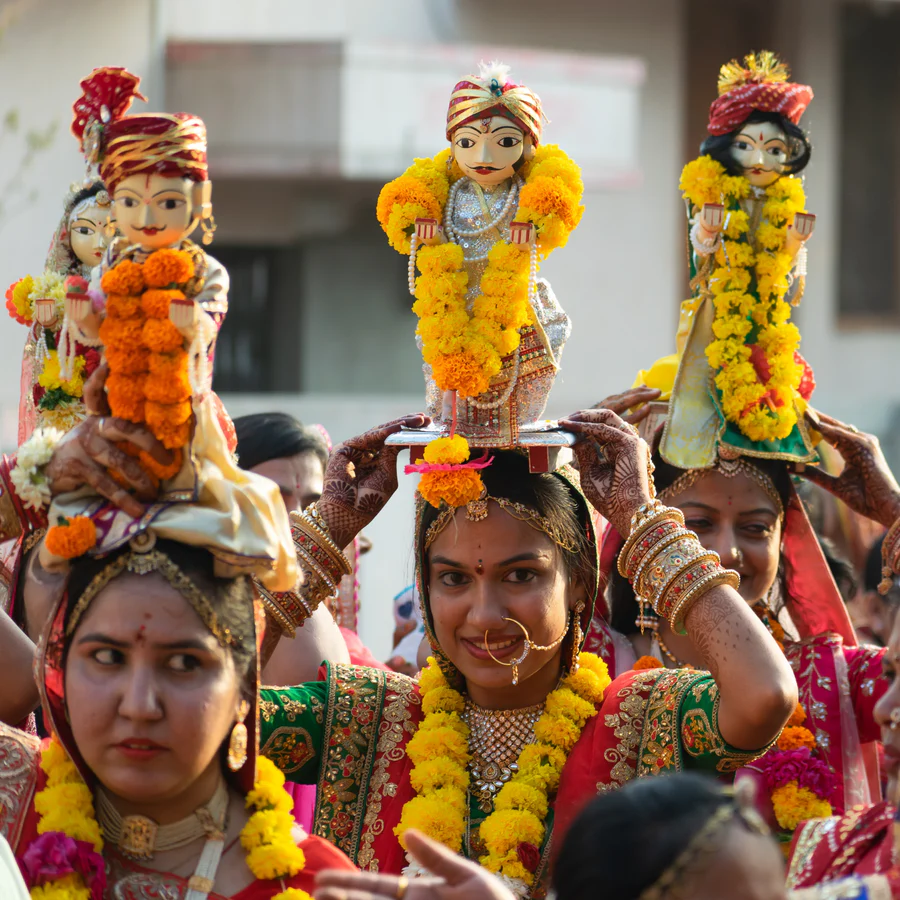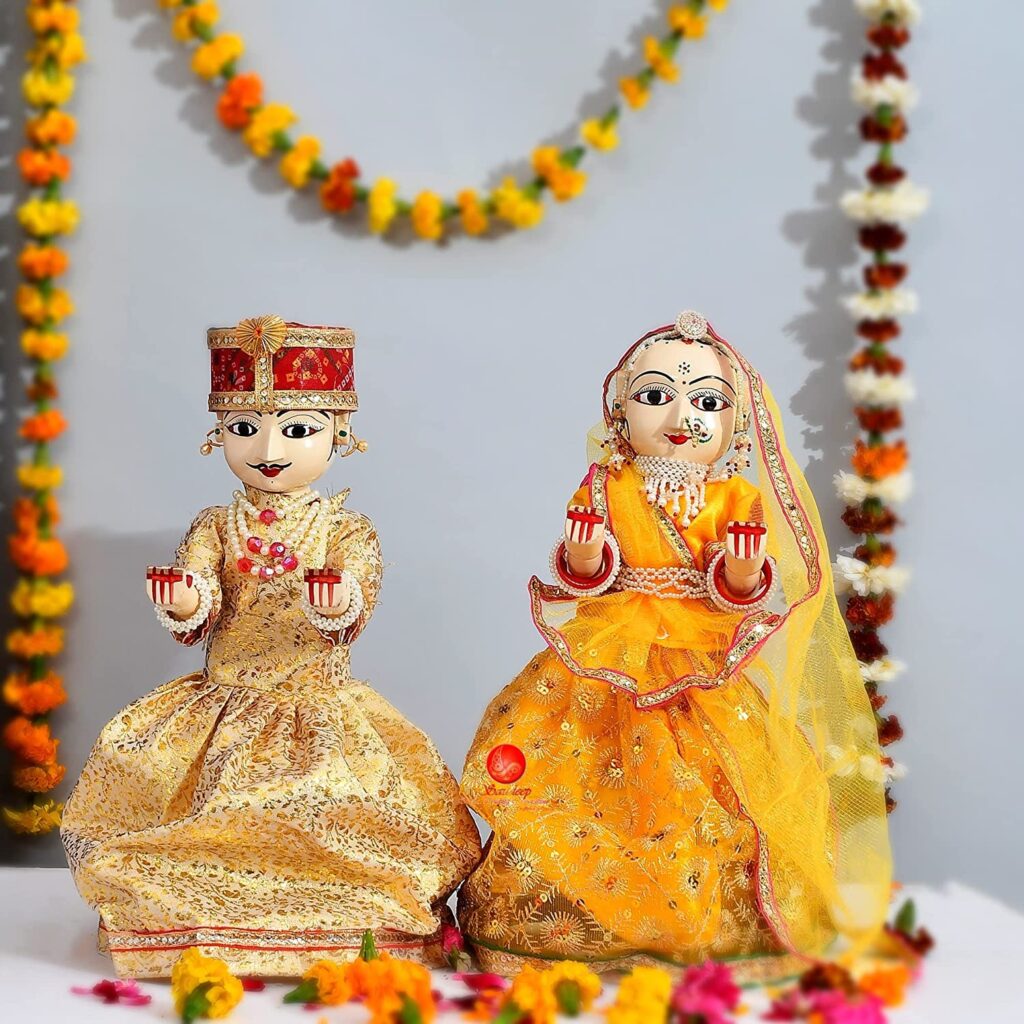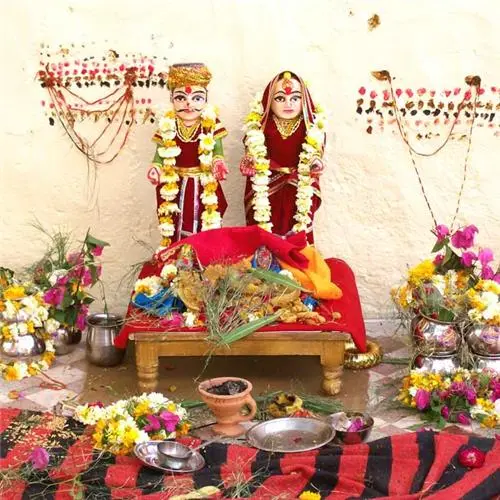Table of Contents
Introduction to Gangaur Festival
The Gangaur Festival is one of the most vibrant and culturally rich Rajasthan festivals, which is cherished in great esteem not only for its religious significance but also because of its artistic, social, and cultural dimensions.

Every year, women all over Rajasthan and adjacent states eagerly await this festival, as it symbolizes love, affection, marriage happiness, and the cosmic bonding between husband and wife.
The name Gangaur itself is a combination of two words—Gana, another name for Lord Shiva (Isar), and Gaur, representing Goddess Gauri or Parvati.
They together symbolize sacred union of masculine and feminine strength, depicting prosperity, fertility, and happiness in household life.
The Gangaur Festival lasts for a period of eighteen days, and it is one of the most complicated and extended Indian festivals.
Women offer rituals in the form of offerings, observe fasts, and participate in folk songs and dance to honor Goddess Gauri during the period.
The difference between the festival lies in the inclusion of married and unmarried women—married women pray for the longevity and prosperity of their husbands, while the unmarried girls seek good life partner graces.
Besides its religious significance, the Gangaur Festival has also evolved as a cultural symbol of Rajasthan.
Jaipur, Udaipur, Jodhpur, and Bikaner are some of the cities where one can witness great processions, with elegantly decorated idols of Isar Gangaur taken on procession in the streets.
These processions, accompanied by folk dances, camel processions, and garlanded elephants, attract locals and tourists alike and turn Gangaur into a festival of fusion of devotion and cultural pride.
The import of Gangaur Pooja is not only in rituals but also in the values which it evokes—faith, patience, love, and reverence for tradition. Despite modernization, the festival is continued with the same zest, attesting to its timelessness.
Origin and Mythological Background of Gangaur
The origins of the Gangaur Festival lie in ancient mythology, and at its core is the myth of Goddess Parvati, or as she is more popularly referred to, Gauri.
In Hindu myth, Gauri was believed to be an avatar of Shakti, or the divine feminine energy, who did hard penance to win the heart of Lord Shiva.
Her efforts and devotion eventually led to their sacred wedlock, which is what the Gangaur Festival commemorates as Isar Gangaur.
It is said that Goddess Gauri proceeded to settle down in her parental home after her marriage for a temporary period.
As she was leaving along with Lord Shiva for Mount Kailash, she showered her married happiness and prosperity upon her female guests.
The beginning of this divine grace set the context of Gangaur Pooja rituals wherein women worship Gauri with complete devotion, beseeching their married happiness and good fortune.
Gangaur Festival has also been historically noted in Rajasthan folklore and traditions. Traditionally, the Rajputana rulers allegedly encouraged celebrating the Gangaur Festival as it not only strengthened family ties but also served to bind the society together as a cultural event.
These traditions became embedded in people’s lives for centuries, and Gangaur thus became a part of Rajasthani culture.
Its symbolic significance goes beyond mythology. Isar Gangaur is a symbol of equilibrium—of strength and sensitivity, discipline and love.
This is the very core of married life, and therefore the women pray to Goddess Gauri at this time for happiness and stability in their homes.
Rituals and Traditions of Gangaur Pooja
The Gangaur Pooja rituals are one of the most striking aspects of the festival, and they reflect both religious devotion as well as cultural artisanship.

The celebrations begin traditionally on the day following Holi and continue for 18 days with the festive farewell of Goddess Gauri.
Each day is marked with serious rituals, many of which are performed by women in intense devotion.
Creating Isar Gangaur clay idols by local artists or by the women themselves is one of the fundamental practices.
The idols are dressed in bright colors, traditional attire, and jewels, symbolizing the divine pair. Pooja of such idols by married women is done by anointing them with turmeric, vermillion, and mehndi as per rituals.
Women also sing folk songs in praise of Gauri and Isar, expressing their love and devotion in song and dance.
A huge component of the Gangaur Pooja is the ghudlias, little earthen pots with perforations, which are adorned with flowers and carried by the young girls in processions.
The girls travel door-to-door, singing the songs of Gangaur and receiving gifts, sweets, or grains in return. This practice emphasizes the social nature of the festival, in that it fosters cooperation and sharing among the community members.
The other important tradition is women’s fasting on the occasion of the Gangaur Festival.
Married women fast so that their husbands are healthy and prosperous, whereas girls who are not yet married fast in the expectation of a good alliance.
This is religious in nature but reflects virtues of patience, forbearance, and self-denial, which are virtues required in family life.
The final day of the Gangaur Festival is also observed with festive processions. Idols of Isar and Gauri are brought out in specially decorated carts or palanquins, accompanied by local artists, musicians, and dancers.
The atmosphere is festive with thousands of devotees gathering to witness the departing couple of gods. In Jaipur and Udaipur cities, these processions are major tourist attractions, drawing tourists from all across the world.
Through these ceremonies, Gangaur Pooja not only preserves the religious significance of the festival but also functions as a cultural unifier, bridging generations with century-old traditions.
Isar Gangaur: The Divine Union
The focal point of the Gangaur Festival is worshiping Isar Gangaur, the heavenly couple—Lord Shiva (Isar) and Goddess Parvati (Gauri).

This union represents love, harmony, and marital strength, thus being central to beliefs that concern the festival.
Isar, the local term for Lord Shiva, signifies strength, self-discipline, and resilience, while Gauri signifies beauty, fertility, and compassion.
Together, they signify the perfect blend of masculine and feminine energies required to be content in family life.
Isar Gangaur is particularly significant to women who are newly wed. The belief is that through worshipping the divine couple, women are granted a long and blissful married life.
The rituals involved in the celebration thus become a symbol of love, faith, and hope for a peaceful future.
Unmarried women also actively participate in the worship of Isar Gangaur, praying to obtain a husband as virtuous as Lord Shiva.
That is one of the reasons why the festival is so widely popular, because it caters to the wishes of women in all phases of their lives.
The Isar Gangaur figures are generally dressed in exquisite designs, ornaments, and colorful attire. These are stored inside homes or temples and worshiped daily until the last procession.
The way women take care of these idols is a testimony to their faith not only in divine grace but even in the virtue of family, loyalty, and love.
In essence, Isar Gangaur is a ritual and not merely a ritual; it is a cultural philosophy that prides itself on relationships, faithfulness, and spirituality in marriage.
7 Astounding Facts About Gangaur Festival
Gangaur Festival is not just rituals—it’s a living tradition, cultural festival, and spiritual journey that has stood the test of time.

Though it’s popularly referred to as a festival of Goddess Gauri and Lord Shiva, there are several unique aspects that differentiate Gangaur from being India’s most fascinating celebration.
Here are 7 interesting facts about Gangaur Festival that reveal its larger context, rich culture, and cultural grandeur.
The Longest and Most Elaborate Rajasthan Festival
Not like most Indian celebrations, which last for a few days only, the Gangaur Festival is very unique in that it takes eighteen days.
Beginning on the day after Holi and culminating in the elaborate farewell of Gauri and Isar, the festival gets people in the mood for worship and celebration for almost three weeks.
Throughout all these long days, women wake up early, take their bath at dawn, and perform daily rituals of Gangaur Pooja.
Isar Gangaur clay images are well ornamented and presented with worship by flowers, mehndi, and old-fashioned sweets.
The length of the festival offers scope for each day to have its own charm—on some days there is singing of folk songs, on others there is ornamentation of the idols, and on the final days there is procession and crowd gathering.
The extended celebration also turns the Gangaur Festival into a time of great reflection and closeness. Families meet, neighborhoods organize fairs, and artisans earn their livelihood by fashioning idols, ornaments, and ornaments for the festival.
A Festival Dedicated to Marital Happiness and Love
Essentially, the Gangaur Festival is a celebration of married love, fidelity, and prosperity.
Women who are already married observe Gangaur Pooja in order to receive blessings for their husband’s good health and longevity, and unmarried girls wish for a good spouse by praying to Goddess Gauri.
This focus on love and devotion makes Gangaur one of the most emotionally significant festivals for women.
It is believed that Gauri’s blessing ensures marital bliss and family harmony. The rituals performed for Isar Gangaur—from applying turmeric and vermilion to observing fasts—are all symbolic of a woman’s devotion to her husband and her hope for a happy married life.
Novelty here lies in the collective involvement of women from different generations. Elder women take the younger generation in performing rituals, thus perpetuating the spirit of Gangaur Pooja generation after generation.
This chain of generations strengthens family values as well as community traditions.
Grand Processions of Decorated Idols Through Rajasthan
One of the most striking aspects of the Gangaur Festival is the beautiful processions of idols. Isar Gangaur’s pictures, gorgeously adorned, are placed on palanquins, bullock carts, or adorned chariots and processed out.
The procession begins in the Zanani-Deodhi (women’s courtyard) of the City Palace in Jaipur and moves along the city center.
Local dancers, folk musicians, elephants, horses, and camels accompany the procession, turning it into a colorful spectacle.
Thousands of onlookers and tourists throng the roads to witness the spectacle of Gangaur Pooja idols draped in colorfully adorned garments, ornaments, and worshipped with humility.
In Udaipur, the festival is observed along Lake Pichola’s shores, where the idols are ferried in boats, casting an otherworldly shadow on the lake.
Similarly, in Bikaner and Jodhpur, local artisans compete with one another to embellish the idols, and the processions become a treat of artistry.
The processions not only contribute to the religious grandeur of the Gangaur Festival but to the artistic and cultural heritage of Rajasthan as well, bringing the world’s attention to it.
Deep Cultural Roots Everywhere Across Cities and States
Although principally associated with Rajasthan, Gangaur Festival does not restrict itself to a single state. It is observed intensely in Madhya Pradesh, Gujarat, and parts of West Bengal.
Each region has its own differences in the rites of Gangaur Pooja, but the basic concept remains the same—Isar Gangaur worship and marital happiness wishes.
In Rajasthan, every city celebrates Gangaur in its own flavor:
Jaipur is renowned for its royal procession and folk shows.
Udaipur blends the festival with its lake environs, which presents an eye treat.
Jodhpur presents the cultural strength of the people through fairs and shows.
Bikaner emphasizes folk songs, dances, and craftsman fair.
In Gujarat, the Gangaur Pooja is typically carried out by Rajput and Marwari women who had settled in the state ages ago. In Madhya Pradesh, especially in Bundelkhand and Malwa regions, Isar Gangaur idols are similarly worshiped.
All this widespread cultural infiltration attests to the manner in which the Gangaur Festival erases space barriers, brings individuals together through shared traditions and values.
Traditional attire, folk songs, and Mehndi
The Gangaur Festival is not just a time of worship—also, it is the celebration of women’s cultural identity in traditional attire, folk music and dance, and art forms.
Married women adorn their finest lehenga-cholis or sarees, while unmarried girls wear celebratory colors, symbolizing youth and hope. Mehndi (henna) patterns are applied to hands and feet, decorating the celebrations.
During Gangaur Pooja, women get together in groups to sing folk songs that are traditionally dedicated to Goddess Gauri and Lord Shiva.
The songs describe the tales of Isar Gangaur, their divine love, and the favors bestowed by marital life.
A few songs also convey the yearning of Gauri to rejoin her husband after a visit to her parental home, which signifies the path of separation and reunion in married life.
The mehndi, dance, and music all combine to produce the festive atmosphere, making the Gangaur Festival a blend of cultural performance and worship.
Festival for Married and Unmarried Women
Another of the most impressive things about the Gangaur Festival is that it is a festival for married and unmarried women.
The majority of Indian festivals are for either married or unmarried women, but the Gangaur is for both.
Married women observe fasts, celebrate Gangaur Pooja, and pray to Isar Gangaur for their husbands’ health and well-being.
Unmarried women pray to Goddess Gauri for a perfect husband as Parvati got Lord Shiva by praying to Him.
This twin engagement renders Gangaur not only a family festival but also a rite of passage for female children.
It is seen by others as a religious pilgrimage that transforms them from childhood to adulthood, instilling values of devotion, patience, and hope.
International Appreciation as a Festival of Cultural Heritage
In the last few years, the Gangaur Festival has gained worldwide fame as one of the most energetic and rich cultural festivals of India.
Foreigners visit cities like Jaipur and Udaipur for the grandeur of processions, beauty of Isar Gangaur idols, and the performances.
Rajasthan Tourism Department organizes special festivals and cultural events during Gangaur time very often, promoting it as an Indian heritage festival.
For tourists from abroad, observing Gangaur Pooja is not just observing rituals but participating in living Indian tradition that is a mix of piety, art, and communal spirit.
This international acceptance has served towards protection and promotion of the Gangaur Festival in a way so that it can keep going strong in present times while preserving its origin.
Cultural Festivals and Fairs during Gangaur Festival
Gangaur Festival is not an in-home ritual; it turns into a lavish public celebration marked by processions, fairs, and cultural performances.
In Rajasthan, especially in Jaipur, Udaipur, Jodhpur, and Bikaner, the festival becomes grand to captivate locals and tourists alike.
Folk Music and Dance Performances
Evenings during Gangaur Pooja are usually filled with folk songs and dance. Traditional songs sung by local artists in praise of Isar Gangaur are on offer, as well as groups of women singing devotional songs passed down from generations.
Ghoomar and Kalbelia are among the dances performed, injecting colour and rhythm into the festivities.
The Jaipur Gangaur Fair
The most popular among these is Jaipur’s Gangaur Fair, from which a royal procession is taken out of the City Palace.
Idols of Isar and Gauri are dressed in expensive attire and jewelry and are seated on palanquins along with caparisoned elephants, horses, and camels.
Musicians, dancers, and folk artists escort the procession, which creates a carnival-like environment. Jaipur turns into a cultural festing center for two days with thousands of tourists flocking the city.
Udaipur’s Boat Processions
During Udaipur, the Gangaur Festival takes a spellbinding form because Isar Gangaur idols are carried to Lake Pichola.
Decorated boats carry the idols across shimmering waters with fireworks lighting up the evening horizon.
Ghats are lined with people and tourists observing this enchanting spectacle. The activity of decorated boats on water adds religious beauty to the celebration.
Rural Celebrations
While large cities embrace large events, rural Rajasthan too celebrates Gangaur Pooja with the same fervor, but in low-key fashion.
Village folk gather in village squares, sing traditional folksongs, and bedeck clay idols of Isar Gangaur.
Such rural festivities attest to the robust cultural heritage of the celebration and prove that the festival is not about quantity, but quality.
Artisan Markets and Handicrafts
The Gangaur Festival also provides an opportunity for artisans and craftsmen to provide a demonstration of their handiwork.
The local bazaars get a boost as stores selling clay idols, wooden handicrafts, jewelry pieces, fabrics, and ornaments spring up.
Travelers prefer purchasing such handicrafts as souvenirs, which is a boon for traditional arts and crafts.
Thus, Gangaur’s cultural festivals and fairs surpass religious rituals—these are a reflection of Rajasthan’s heritage, its craftsmanship, and its collective morale.
Symbolism of Gangaur in Today’s Times
While the Gangaur Festival does have roots in history, its symbolism today is just as active. In fact, the festival has meshed well in today’s times but has retained its spiritual foundations intact.
Preservation of Traditions in a Modern World
With the contemporary, fast moving, technology-oriented lifestyle of the present times, most traditions are losing their strength.
But Gangaur Pooja remains unbroken, partly because it is based on universal values like love, dedication, and harmony. Urban dwelling families still prepare idols from clay, women still fast, and folk songs still resound.
Even the younger generations now reflect greater awareness about the cultural and religious significance of the festival.
Women’s Empowerment and Social Symbolism
Although the festival is about devotion to husbands, these days numerous women also celebrate the Gangaur Festival as a showcase of woman power, strength, and commitment.
Goddess Gauri is not merely the epitome of marital happiness but of independence, imagination, and tenacity.
For many women, the rituals of Isar Gangaur are a witness to the power of a woman to nurture, protect, and lead her family with honor.
Tourism and Cultural Exchange
Gangaur Festival has become a grand cultural tourism destination. Jaipur and Udaipur cities witness thousands of foreign and domestic tourists flocking to watch the show and pomp of the processions, folk performances, and artistry of the idols.
This has led to culture exchange—foreigners become educated about Indian culture, but local people also financially benefit from tourism.
Continuity of Folk Arts and Crafts
Modernization has threatened traditional arts, but festivals like Gangaur provide a way of survival.
The artists who make clay figures of Isar Gangaur, folk singers who sing songs that have been around for centuries, and the dancers who perform traditional dances become significant in this festival.
Thus, the Gangaur Festival plays an important part towards the survival of these arts.
Global Recognition of Indian Festivals
In the past few years, the Gangaur Festival has been designated as a cultural heritage festival at the global level.
Videos and documentaries depict its beauty to the world, and more value is given to India’s diverseness.
Gangaur represents India’s syncretism of spirituality, artistry, and cultural pride for many Indians abroad.
In this way, the symbolism of Gangaur today lies not merely in its rituals but also in its ability to adapt, inspire, and transmit values from generation to generation.
Conclusion
Gangaur Festival is far more than a ritual festival—it is a symbol of love, devotion, prosperity, and cultural identity. Originating in myth and spread by custom, it continues to live in people’s hearts even today.
Be it the magnificent processions of Jaipur or boat festivals of Udaipur or simple village ceremonies, the meaning of Gangaur Pooja is always the same: the adoration of Goddess Gauri and Lord Shiva as Isar Gangaur, the timelessness couple that symbolizes the beat of wedded bliss.
It is special because it is inclusive—married women pray for the well-being of their husbands, and unmarried girls pray for a good husband.
This dual involvement makes it a festival of both worship and hope. The artistry of clay idols, the rhythms of folk music, and the merriment of village fairs symbolize the anchorage of Rajasthan’s culture.
In contemporary times, the Gangaur Festival has gone beyond borders, reaching the world as a living cultural heritage.
It is a bridge that connects the past and the present, a symbol that reminds us that even in the era of change, the concepts of love, devotion, and harmony are perennial.
Last but not least, the Gangaur Festival is not so much a matter of piety—it’s about preserving identity, paying respect to relationships, and continuing traditions that carry on for generations.
In ritual, song, and celebration, the people of Rajasthan reassert their connection to religion, culture, and the eternal values that make life worth living.
